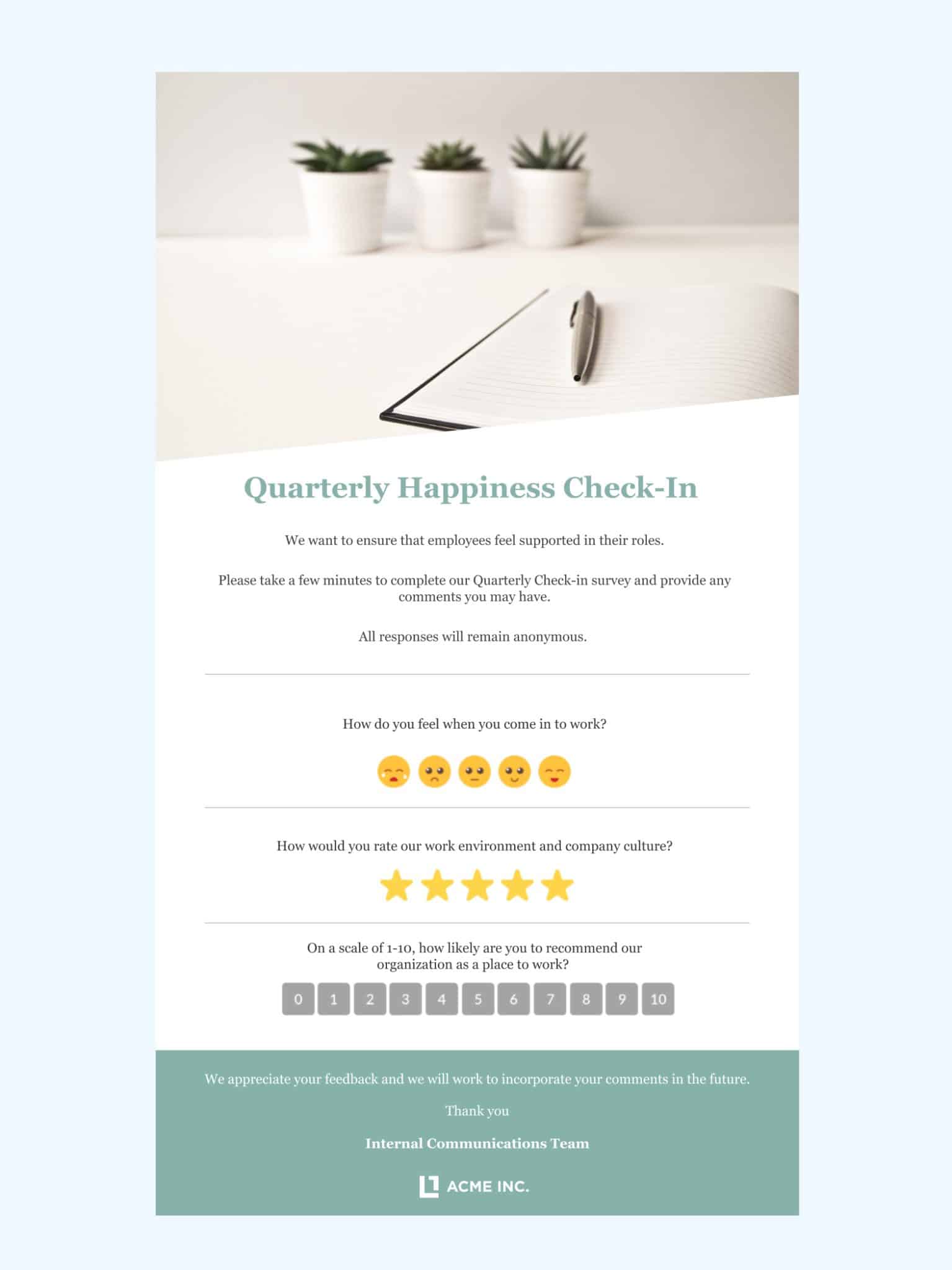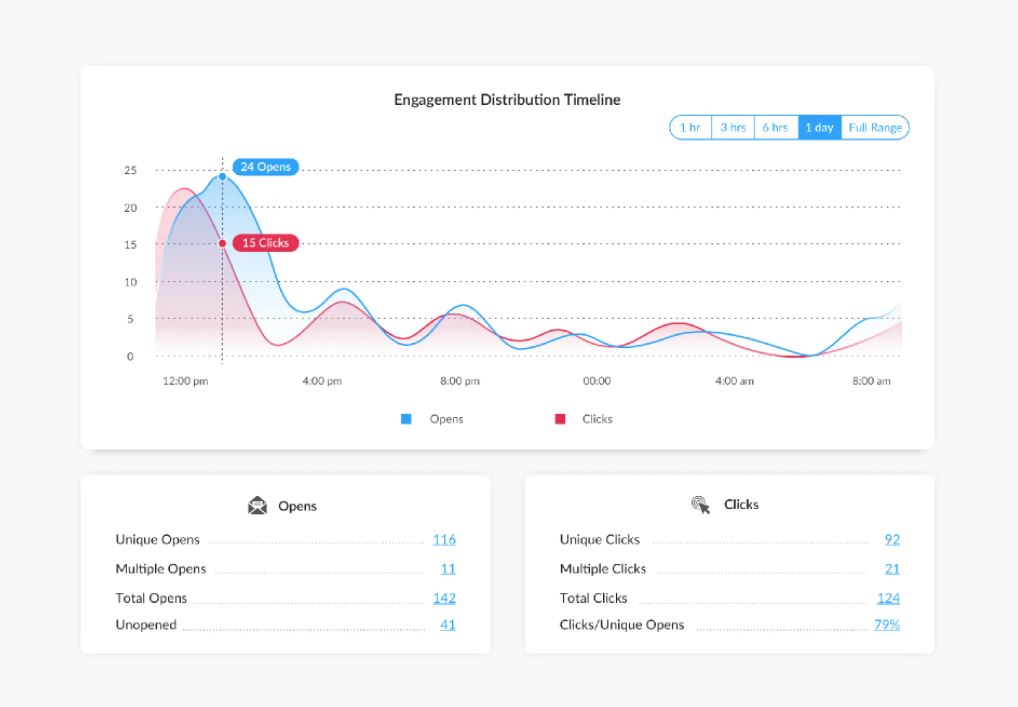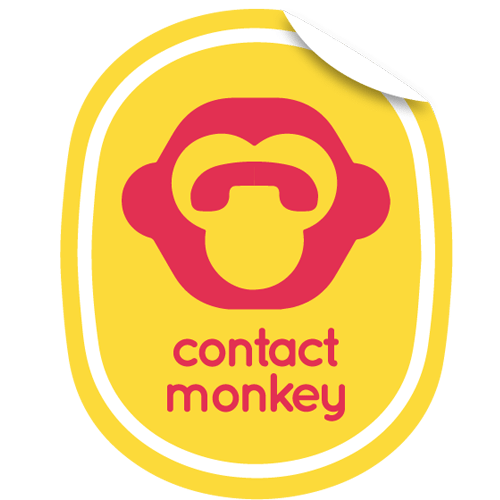How can healthcare organizations keep their staff motivated to deliver top-notch patient care? In a field where compassion and dedication are crucial, engaging employees is key to ensuring outstanding healthcare services.
The healthcare industry is a cornerstone of our society, providing essential services that we all rely on.
Unfortunately, it’s no secret that healthcare professionals face intense stress and demanding work environments, which lead to disengagement and often even burnout. Initiatives to drive employee engagement in healthcare are thus not just important for employee happiness—they have a direct impact on patient outcomes.
In this post, we delve into healthcare employee engagement, why it’s so important, and how it can transform both the work environment and patient care. We’ll share our top strategies for boosting engagement among healthcare staff, as well as highlight how ContactMonkey’s internal communication software can play a pivotal role in achieving your engagement goals.
By implementing these strategies and leveraging the right tools, healthcare organizations can create a more supportive and effective workplace. Read on to discover how to enhance employee engagement in your healthcare organization and ensure that your staff and patients thrive.
How much is low employee engagement costing you?
What is Employee Engagement in Healthcare?
Employee engagement in healthcare refers to the emotional commitment and involvement of healthcare staff in their work and the organization. It’s about creating an environment where healthcare professionals feel connected to their roles, passionate about their responsibilities, and dedicated to helping their patients.
Healthcare employee engagement encompasses more than just job satisfaction. Engaged healthcare employees are enthusiastic about providing excellent patient care, committed to improving health outcomes, and invested in the success of their healthcare facility.
These employees go above and beyond their basic job requirements, often finding innovative ways to enhance patient experiences and streamline processes.
Engaged healthcare employees typically demonstrate:
- A strong sense of purpose in their work
- High levels of energy and enthusiasm
- Willingness to collaborate with colleagues
- Dedication to continuous learning and improvement
- Resilience in the face of challenges
Why Is Employee Engagement Important in Healthcare?
Employee engagement in healthcare isn’t a buzzword; it’s a critical factor that can make or break an organization’s success. When healthcare workers feel engaged, the positive effects ripple through every aspect of the institution—and through patient results.
Engaged employees in healthcare directly contribute to improved patient care. These professionals pay closer attention to details, show genuine empathy, and make a point of consistently delivering high-quality care. This heightened level of dedication translates directly into better patient outcomes (not to mention a stronger reputation for the healthcare facility).
Furthermore, employee engagement fosters a positive work environment, with staff members driving better teamwork, improved communication, and a more cohesive workplace culture.
It’s important to note that the goals of employee engagement in healthcare extend beyond just making employees happy. They encompass creating a workforce that is emotionally invested in the organization’s mission, committed to delivering excellent patient care, and driven to contribute to the overall success of the healthcare institution.
That’s why prioritizing healthcare employee engagement is not just beneficial—it’s essential. It creates a win-win situation where employees are better at supporting one another, patients receive better care, and healthcare organizations flourish.
Our 5 Key Tips on How to Increase Employee Engagement in Healthcare
Promoting employee engagement in healthcare organizations presents unique challenges. The high-stress environment, long hours, and emotional demands of patient care all take a toll on healthcare workers. However, implementing thoughtful healthcare employee engagement strategies can make a world of difference.
Let’s explore some best practices that healthcare leaders can adopt to create a supportive work environment where healthcare professionals feel valued, motivated, and supported in executing their duties. Here’s how to increase employee engagement in healthcare:
1. Foster a Culture of Recognition
When healthcare professionals feel valued, they’re more likely to stay motivated and committed to providing excellent patient care. That’s why recognition plays a crucial role in boosting employee engagement in healthcare settings.
Implementing recognition programs doesn’t have to be complicated or expensive. Simple gestures like public acknowledgment of outstanding performance, personalized thank-you notes, or employee-of-the-month awards can go a long way. More comprehensive programs might include performance-based bonuses, extra time off, or opportunities for career advancement.
To implement an effective recognition program, healthcare organizations should:
- Make recognition timely and specific
- Encourage peer-to-peer recognition
- Align recognition with organizational values and goals
- Use a mix of formal and informal recognition methods
- Ensure recognition is fair and consistent across all departments
Remember, fostering a culture of recognition is an ongoing process. It requires commitment from leadership and should be integrated into the organization’s overall employee engagement strategy.
But it’s worth doing! When employee engagement and healthcare quality are so inextricably linked, engagement initiatives done right not only transform workplace culture they also improve patient outcomes.
15 employee appreciation emails
Recognize your team’s hard work with these templates.
2. Provide Opportunities for Professional Development
Often, the answer to how to increase employee engagement in healthcare is to provide opportunities for workers to improve and grow within their roles.
In fact, continuous learning is an ongoing obligation for most healthcare workers, and it is necessary to keep them sharp and up-to-date on advancements, best practices, and technologies in the field so that they can provide the best possible patient care.
By providing opportunities for professional development, healthcare employers show an investment in supporting their employee’s growth throughout their careers. In turn, healthcare professionals can enhance their skills and increase their confidence, leading to higher job satisfaction, better patient outcomes, and often, a renewed motivation to excel in their role.
There are various types of development opportunities that healthcare organizations can offer:
- Workshops and seminars
- Online courses and certifications
- Mentorship programs
- Cross-training initiatives
- Conference attendance and presentations
- Research opportunities
The impact of professional development on engagement is significant. Employees who feel competent and knowledgeable in their roles are less likely to be overwhelmed or suffer from burnout and are more likely to feel connected to their roles.
Moreover, as employees learn and grow, they bring new ideas and perspectives back to their teams, elevating the organization’s performance. These engaged employees are more likely to innovate, solve problems creatively, and provide exceptional patient care.
3. Promote Work-Life Balance
The importance of work-life balance in healthcare cannot be overstated. Healthcare professionals face demanding schedules and high-stress situations and are at high risk for burnout and complete disengagement from their work.
When healthcare workers feel overwhelmed and exhausted, it can lead to decreased productivity, increased medical errors, and a higher turnover rate. In fact, according to Statistics Canada, 63.2% of healthcare workers who reported their intention to leave their jobs in 2021 cited job stress or burnout as their reason.
By prioritizing work-life balance for healthcare workers, employers can create a sustainable environment and ensure employees can consistently deliver excellent patient care without sacrificing their own well-being.
Several strategies can effectively promote work-life balance in healthcare settings:
- Allow flexible scheduling: Offer options like compressed workweeks, job sharing, or flexible start and end times to accommodate personal needs.
- Ensure adequate staffing: Ensure proper staffing levels to prevent overwork and excessive overtime.
- Provide mental health support: Provide access to counseling services, stress management programs, and resources for emotional well-being.
- Offer paid time off: Offer generous vacation and personal days, and encourage employees to use them.
- Make use of technological solutions: Utilize scheduling software and communication tools to streamline workflows.
- Set clear boundaries: Establish policies that discourage after-hours work communications and respect employees’ personal time.
By implementing these strategies, healthcare organizations can significantly reduce burnout among their staff and ensure a more engaged workforce.
4. Ensure Open Communication Channels
Open and transparent communication between management and staff is essential for building trust and improving employee engagement in healthcare settings. Not only is open communication important for disseminating crucial information, it’s also key for obtaining (and acting on) feedback from employees.
Employee feedback helps employers understand how to make employees feel appreciated. Plus, but asking employees to identify concerns they have, employers can head off issues at the pass, keeping employees satisfied and preventing turnover within their organization.
There are numerous other benefits to establishing strong internal communication in healthcare, including:
- Improved patient care through better coordination and information sharing
- Faster problem-solving and innovation
- Enhanced trust between management and staff
- A more cohesive and aligned workforce
To improve communication, healthcare organizations can implement several strategies:
- Town hall sessions: Host organization-wide meetings where leadership can address the entire staff and answer questions directly.
- Open-door policies: Encourage leaders to be accessible.
- Digital communication tools: Utilize internal communication platforms or apps to keep everyone connected, especially in large healthcare facilities.
- Anonymous feedback channels: Provide ways for employees to share honest feedback without fear of repercussions.
The importance of employee engagement surveys in healthcare also cannot be overstated, as they provide valuable insights into the workforce’s needs and concerns.
Pulse surveys that actually engage employees
Turn emails into conversations.
5. Invest in Leadership Development
Strong leadership is the backbone of employee engagement in healthcare settings. Leaders set the tone for the entire organization, influencing everything from workplace culture to patient care quality.
The benefits of strong leadership in healthcare are far-reaching. Effective leaders:
- Manage employee workloads to prevent burnout
- Identify potential stumbling blocks
- Encourage innovation and creative problem-solving
- Inspire trust and confidence among staff
- Promote a sense of purpose and a shared vision
When healthcare leaders excel, their presence is felt throughout an organization. Strong leaders not only drive better performance but also create a more satisfying and fulfilling work environment for all staff
This is why healthcare organizations should prioritize leadership development programs that equip managers and supervisors with skills such as emotional intelligence, effective communication, conflict resolution, and strategic thinking.
How do you maximize the impact of leadership development? Consider:
- Tailoring programs to the unique challenges of healthcare leadership
- Providing ongoing coaching and mentoring opportunities
- Encouraging leaders to model the behaviors they want to see in their teams
- Measuring the impact of leadership development on employee engagement and patient outcomes
By preparing your leaders to face the unique challenges of increasing employee engagement in healthcare, you ensure a workplace where employees feel listened to, supported, and understood by leaders. In turn, employees will be better able to withstand the daily stresses and challenges of working in the healthcare industry.
How ContactMonkey Helps Drive Employee Engagement in Healthcare
ContactMonkey is an internal communication software that helps organizations streamline and enhance their engagement efforts. With tools for creating, sending, and tracking internal emails and SMS messages, ContactMonkey helps businesses improve their internal communications, gather valuable employee feedback, and foster a more connected and informed workforce.Let’s look at some of the reasons you should consider using ContactMonkey as one of your employee engagement tools for healthcare.
Ask for employee feedback with pulse surveys
Using ContactMonkey’s drag-and-drop email builder, you can easily build and send employee survey emails to get a quick pulse check on your healthcare organization. You can even embed pulse survey questions into other emails you send, like a regular employee newsletter, to make it easier to reach your audience.
Employees can answer directly from their inboxes and even leave anonymous comments with their votes to elaborate any additional context or information required.

Choose from eNPS, emoji reactions, thumbs up and thumbs down, and many more survey options, then watch responses roll in in real-time on your ContactMonkey Dashboard.
ContactMonkey will even calculate your employee net promoter score for you based on your survey results.
Track employee engagement with robust analytics tools
Refine your communication approach over time by tracking how your emails perform on your ContactMonkey internal email analytics dashboard.

Any emails you send through ContactMonkey can be tracked in one of three ways: overall, individual, or anonymous tracking. Choose the level of detail you want in your analytics and begin tracking your employee’s interaction with your content to see opens, clicks, email read time, and much more for all your internal emails.
By tracking email metrics, you’ll be able to see how tuned-in employees in your organization are and hopefully identify problems before they grow.
Host successful seminars, employee appreciation events, and more with event management
Hosting a professional development seminar? Want to throw an employee appreciation event to engage your hardworking healthcare professionals?
ContactMonkey’s event management feature allows you to build events directly in your ContactMonkey dashboard, design custom registration forms, and embed invites in any email you send.
Event planners can track registrations and collect information they need from attendees (such as food preferences and allergy information) with the custom form fields. As for employees, event management makes it easy for them to RSVP directly from their inboxes and get an .ICS file to add the event to their calendar.
Event planning goes off without a hitch, successfully making employees feel informed, appreciated, and engaged.
Send crisis communications with employee SMS
Using ContactMonkey’s SMS messaging for healthcare, you can text employees en masse during crisis situations or when time is of the utmost importance. This keeps healthcare employees in the loop and allows them to respond quickly, no matter where they are.
See the Difference Engaged Healthcare Workers Can Make
Employee engagement in healthcare is critical for delivering high-quality patient care and maintaining a thriving healthcare organization.
Recognizing employees, providing development opportunities, promoting work-life balance, keeping lines of communication open, and investing in strong leadership are all practices that contribute to an environment where healthcare workers feel valued, supported, and inspired to give their best. Thus, promoting healthcare employee engagement is a way to invest not only in your staff but also in the future of healthcare itself.
Take action in implementing some of the healthcare employee engagement suggestions above, and consider bringing in an employee engagement software like ContactMonkey to help you communicate with your employees, drive engagement initiatives like pulse surveys, and measure the impact of increased engagement in your organization.
Want to improve employee engagement in the healthcare industry? No problem! Book a demo with ContactMonkey today to discover how our internal communications tools can help you foster a more engaged, connected, and motivated healthcare workforce. Your employees—and your patients—will thank you for it.










